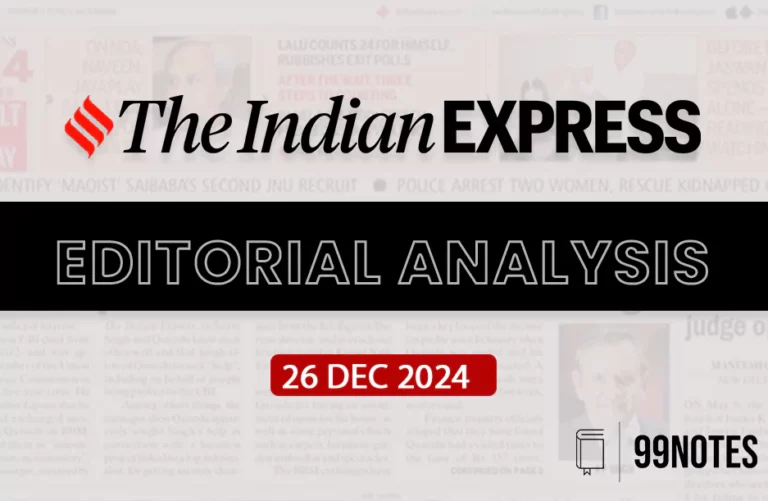14 August 2024 : The Hindu Editorial Analysis
1. Hints of the corporatisation of science research in India
(Source – The Hindu, International Edition – Page No. – 8)
| Topic: GS2 – Governance, GS3 – Science and Technology |
| Context |
|
Introduction:
- Prime Minister Narendra Modi, during his address at the 107th Science Congress in Bengaluru in January 2020, emphasised the need for innovation in science, encapsulating the government’s vision with the maxim: “Innovate, patent, produce, prosper.”
- This phrase reflects the government’s shift towards a new policy on knowledge production, emphasising the commercialization of research and self-reliance in science.
Shift Towards Market-Driven Research:
- Over the years, the Indian government has encouraged laboratories and research centres to generate revenue by marketing their expertise and patents, moving towards corporatization of science research.
- This approach was formalised in the ‘Dehradun Declaration’ (2015), where the Council of Scientific and Industrial Research (CSIR) labs were directed to market patents to self-finance research.
- This shift indicates the government’s inclination towards transforming state-owned research entities into market commodities, encouraging them to follow a business model rather than relying on public funding.
Establishment of Anusandhan National Research Foundation (ANRF):
- The Anusandhan National Research Foundation (ANRF) was established under the ANRF Act of 2023, designed to fund research in India and strengthen linkages between research, academia, and industry.
- The Finance Minister highlighted the operationalization of the ANRF in the July 23, 2024 Budget speech, emphasising basic research and prototype development as crucial components of the innovation cycle.
- A significant aspect of this development is the private sector’s contribution, with 72% of the ₹50,000 crore funding expected from private entities, showcasing the government’s strategy to reduce its financial involvement and boost private entrepreneurship in research.
Comparison with Global Trends:
- The article draws a parallel with the United States, where research and development are increasingly driven by the private sector, particularly in IT and pharmaceuticals.
- In this context, science has evolved from a purely academic pursuit to a market-driven enterprise, where intellectual property rights enable universities to sell patents to private corporations, even when the research is publicly funded.
- This transformation is a result of the global adoption of neoliberal economic policies, leading to greater private sector involvement in funding scientific research.
Concerns Over Market-Driven Science:
- Despite the ANRF’s stated objective to fund natural sciences, there are concerns that the government is subtly aligning university research with the “dictates of the capitalist market”.
- Curiosity-driven research, which seeks to understand natural phenomena without immediate market applications, is unlikely to attract private funding due to its lack of direct profitability.
- There are concerns about the discrepancy in government funding, pointing out that while Indian Knowledge Systems receive support, evidence-based scientific research faces stringent funding conditions.
The Need for Public Funding in Science:
- It is Important to understand the role of public funding in promoting curiosity-driven science, which is essential for advancing knowledge and innovation.
- Basic scientific research, which aims to understand natural processes without focusing on immediate applications, requires a supportive environment and financial autonomy to thrive.
- Without increased public funding, India risks undermining curiosity-driven science, leading to a potential decline in public trust in science as private interests dominate.
Country Comparison and Recommendations:
- India’s investment in science research remains low at 0.6% to 0.7% of GDP, compared to countries like South Korea, which spends around 2% to 3% of its GDP on science.
- The Indian government must increase its allocation for basic science and non-profit research to prevent the decline of curiosity-driven science in universities.
- Additionally, it is Important to maintain financial and administrative autonomy in scientific institutes to foster a culture of free inquiry, which is crucial for the growth of scientific research.
Conclusion:
- The tension between the grand vision of scientific innovation and the repressive societal conditions that may hinder academic freedom and innovation in India.
- The growing political and ideological intervention in public universities is a concern that must be addressed to ensure the healthy development of science and research in the country.
| PYQ: Scientific research in Indian universities is declining, because a career in science is not as attractive as our business operations, engineering or administration, and the universities are becoming consumer oriented. Critically comment. (200 words/12.5m) (UPSC CSE (M) GS-3 2014) |
| Practice Question: Critically analyse the impact of the corporatization of scientific research in India, with specific reference to the Anusandhan National Research Foundation (ANRF) and its implications for curiosity-driven science. (250 Words /15 marks) |
2. Expanding contraceptive choices
(Source – The Hindu, International Edition – Page No. – 9)
| Topic: GS2 – Social Justice – Health |
| Context |
|
Introduction:
- A recent study published in the journal Contraception X highlights the potential of Levonorgestrel 1.5mg for pericoital use, which refers to contraception methods used at the time of sex, such as condoms and diaphragms.
- This underscores the importance of diversifying contraceptive choices to cater to the unique needs of women and girls.
- In India, the sale of oral emergency contraceptive pills (ECPs) has surpassed 35 million annually, reflecting a decadal compounded annual growth rate (CAGR) of 12%.
Emergency Contraception (ECPs):
- Emergency contraception is used to prevent pregnancy after sexual intercourse and is most effective when used within five days, especially sooner after unprotected sex.
- The World Health Organization (WHO) asserts that ECPs are safe for all women, including those who cannot use hormonal contraceptive methods.
- The use of ECPs is also a reminder for women to consider starting a regular contraceptive method to prevent pregnancy from future sexual acts.
Role of Public and Private Sectors:
- In India, the public sector remains the primary source for family planning services like sterilisation and long-acting reversible contraceptives (LARCs).
- The private sector is the leading provider of oral contraceptive pills, ECPs, and barrier methods like condoms, giving women the agency and autonomy to make decisions about their reproductive health.
Inclusion in National List of Essential Medicines (NLEM):
- In 2024, the Indian government included Levonorgestrel 1.5 mg in the National List of Essential Medicines (NLEM) to ensure affordable and quality access to this preferred emergency contraceptive.
- This inclusion addresses a significant market disparity, as previously, only the two-dose regime (0.75 mg tablets) was price-controlled under NLEM, while the single-dose regimen was not.
- Levonorgestrel 0.75 mg tablets were introduced in the National Family Planning Programme in 2003 and later replaced by Levonorgestrel 1.5 mg tablets, which are available free of cost across public health systems.
India’s Progress in Family Planning:
- India has achieved the replacement level of fertility, where the population replaces itself without migration, reflecting the government’s success in expanding contraceptive options and promoting education for quality living.
- Despite this, regional variations persist in access to contraceptives, and the total demand for family planning among currently married women (ages 15-49) increased from 66% in 2015-16 to 76% in 2019-21.
- The unmet need for family planning decreased from 13% to 9% during the same period, indicating progress but also highlighting that 9% of women still lack access to contraceptives.
Ongoing Efforts and Future Prospects:
- As research and technological advancements continue, contraceptive options will expand to better meet the unique needs of men and women.
- Policymakers must continue to listen to and address the needs of women and their partners across different life stages.
- Recent initiatives, such as subcutaneous injectable contraceptives and sub-dermal single rod implants in national programs, alongside the price control of the single-dose ECP, illustrate the government’s commitment to supporting women in making informed reproductive choices.
| Practice Question: Examine the challenges and opportunities in ensuring equitable access to contraceptives across different regions in India, and discuss the role of policy interventions in addressing unmet needs in family planning. (150 Words /10 marks) |




